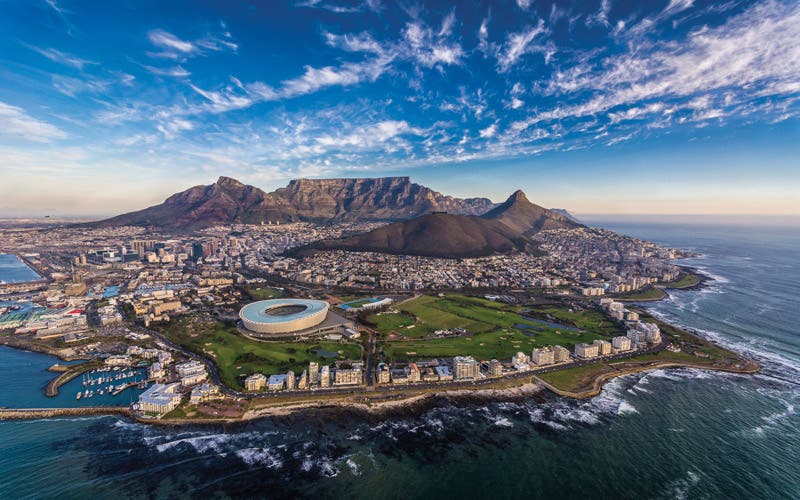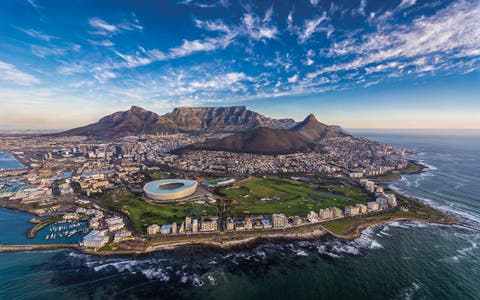Fun Facts You Didn’t Know About Cape Town
Cool and quirky lesser-known truths about the Mother City
Last Updated: 7 March 2017
Think you’re clued up on all there is to know about the Mother City? Think again! There’s a whole heap of quirky little titbits of info about our pretty metropolis that you’re unlikely to be familiar with. So, in an effort to keep you on your toes, we’ve compiled an overview of fun facts about Cape Town, at least some of which we’re sure you’ve never heard before.
THINGS YOU DIDN’T KNOW ABOUT CAPE TOWN
Cape Town is South Africa’s tobogganing hub
Fancy slipping and sliding downhill in a sled? The Mother City is the place to do it. Although over 300 tobogganing tracks exist worldwide, Cape Town is home to the only one in Africa, aptly titled Cool Runnings after the film about Jamaica’s first bobsled team. If you’re keen on visiting, you’ll find the track just 25km outside of the city centre on Carl Cronje Drive.
Two couples get hitched on Table Mountain every month
Our precious flat-topped mountain began forming around 280 million years ago, and today, it’s still evolving! The cableway, on the other hand, was erected in 1929 and was originally constructed from wood and steel (sounds pretty dangerous to us, but there have been no accidents on it as of yet). Another fun fact: it’s estimated that two couples get hitched on the mountain every month. Wowzers! And did we mention that the Table Mountain National Park, which spans an area of 22 000 hectares, boasts more plant species than the British Isles or New Zealand?

Cape Town was appointed the best place in the world to visit by the New York Times in 2014
The Mother City racked up some serious awards in 2014: our pretty city was named the best place in the world to visit by The New York Times, appointed World Design Capital 2014, featured second in Travel and Leisure’s list of top holiday destinations and deemed the second best African city to visit by TripAdvisor’s 2014 Travellers’ Choice awards. Similarly, did you know that in 2013 the UK publication The Guardian named the Sea Point swimming pool one of the top ten swimming pools in the world?
The Castle of Good Hope once had a sea view
Cape Town’s famous landmark the Castle of Good Hope is the oldest colonial building in South Africa, having been built between 1666 and 1679. The structure, which was once a fort, served as a welcoming port for sailors travelling around the Cape – an often arduous journey. Despite popular belief, it was not built by Jan van Riebeeck; although, a temporary clay and wooden fort was built during his time at the now Golden Acre shopping centre. Though the years have reshaped the Castle’s surrounding landscape, it is hard to imagine that at one time the star-shaped building had waves lapping at the entry point (the entrance was later moved for this very reason)! Today, the castle exists as a ceremonial base for Cape regiments of the South African Defence Force.
Lion’s Head wasn’t actually named for its felines
Despite speculation, Lion’s Head does not take its name from being host to some big cats. The story goes that during the 17th century Dutch settlers named the peak Leeuwen Kop (Lion’s Head) and its adjacent summit Leeuwen Staart (Lion’s Tail aka Signal Hill as it’s known today). It was thought that the space between the two peaks is suggestive of a crouching lion.
The Mother City is host to the mother of all queer parties
Cape Town is home to the largest dress-to-theme costume party in South Africa, the Mother City Queer Project (MCQP), which also happens to be one of the biggest lesbian, gay, bisexual, transgender and queer (LGBTQ) annual events on the African continent.
Afrikaans is the most widely spoken language in the Western Cape
Despite being one of the youngest languages in the world, Afrikaans is the most widely spoken tongue in the Western Cape, with isiXhosa and English racking up second and third places. Another fun fact about local demography? According the 2011 population census, the Western Cape populace has a (slightly) feminine edge – with 50.9% of us being women. Girl power!
The Cape Floral Kingdom claims nearly 7000 plants found nowhere else in the world
The Cape Floral Kingdom, which spans 90 000sq km, is the smallest and richest recognised floral area on the planet and was declared a world heritage site by UNESCO’s committee. Of the 9600 species of plant life that are found in this kingdom, around 70% occur nowhere else in the world. These include the likes of the honey buchu, peninsula snapdragon and Good Hope satinflower.
The Cape Peninsula was originally known as the Cape of Storms
As a result of the terrible tempests that have been known to rock the Mother City’s coastline, the Cape Peninsula was originally nicknamed the ‘Cape of Storms’ by legendary explorer Bartholomew Dias. Later, it became known as the Cape of Good Hope because it offered colonial powers the promise of a sea route to the East.
Dr. Christiaan Barnard’s groundbreaking surgery was bittersweet
While most are familiar with the fact that Dr Christiaan Barnard performed the first-ever heart transplant in 1967 at Groote Schuur Hospital, not so many know that his patient passed away shortly after. Sadly, Mr Louis Washkansky, the man who received the revolutionary cardiac surgery, lived only 18 days post operation due to the onset of pneumonia. The original theatre where the awe-inspiring act took place is today a museum, aptly named Heart of Cape Town.
We’re all young here!
The 2011 national census reports that almost half (43.2%) of the Western Cape’s population is below the age of 25 – it seems the city is a fountain of youth! If you find the location of this age-defying waterspout, let us know!
Cape Town nearly followed in Australia’s footsteps
Adderley Street, the iconic Cape Town street that is today famous for its flower and fruit-and-veg sellers, took its name from Mr Charles B. Adderley, who passionately protested against a plan by the British government to turn Cape Town into a convict colony. History books have it that the road was originally made entirely from wooden blocks, but these were ultimately covered over with tar to make the road we know today. Remnants of these wooden tiles can still be found towards the upper end of the street today. So keep your eyes peeled next time you’re in search of a beautiful bouquet in the city centre!
Cape Town has the country’s highest number of homes valued at more than R20 million
Business Day recently reported that while Jozi’s home to most of South Africa’s wealthiest (48% live in the City of Gold), the Mother City has more “trophy homes” - houses valued at over R20 million. Furthermore, it seems that the most sought-after spot of turf for those living it lush is Camps Bay, where there are 155 properties valued at more than R20 million.
Cape Town is the most equal city in South Africa
Though the ANC and DA might never come to consensus over who will most effectively run the Western Cape, both the UN-Habitat’s (the United Nations agency for human settlement) 2010/11 and 2012/2013 State of the World’s Cities reports concluded that Cape Town is the most equal of all South African cities. According to the account, which looks at income inequality, the three cities topping the inequality list are Buffalo City (East London), Johannesburg and Ekurhuleni (East Rand).
Use our events section for an up-to-date overview of happenings in Cape Town. Also, don’t forget to subscribe to our newsletter and if you have a smartphone, add m.capetownmagazine.com to your home screen for quick access on the go!
CapeTownMagazine.com
| For Moments of Joy. Follow our social channels for useful news, daily local champions | |
| 072 350 2062 | |
| Ideas Cartel, The Old Foundry, 1 Sand Hill Road, Green Point | |
| www.capetownmagazine.com/subscribe | |
| now@capetownmagazine.com | |
| CapeTownMag | |
| CapeTownMagazine.com | |
| capetownmag | |

